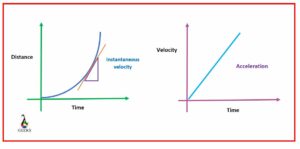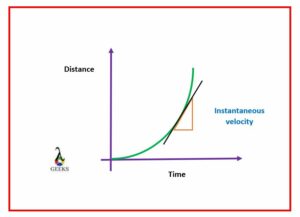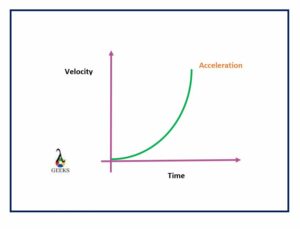We are already familiar with the terms velocity and acceleration. In this post, we will know instantaneous velocity vs acceleration facts.
Velocity and acceleration are interrelated with each other. Instantaneous velocity is the calculation of velocity at any particular period, and acceleration is defined as the rate of change Velocity(V) with consideration to a period. If we take the derivative of Vinst with t, then we get acceleration.
In this article, we will concentrate more on Instantaneous velocity vs acceleration in detail.
Instantaneous Velocity: Definition and Facts
The term velocity is used to indicate or measure the particle’s speed in a period.
- We know that the significance of velocity and what it denotes. Now coming to the word instantaneous velocity, it denotes the increase or decrease in particle speed in a particular period, i.e., it shows the speed at a required instant of time.
- It is measured along the path on which the particle moves in consideration.
- The graph used to plot instantaneous velocity (Vinst) shows the change of speed, i.e., increase or decrease of a body.
Now let us know about the other necessary quantity that we will focus on instantaneous velocity vs acceleration.

Acceleration: Definition and Facts
Acceleration is another important term used in everyday physics.
- Acceleration in physical sciences is one of the essential quantities without which the basic calculation of mechanics is not possible.
- It is, in general, given as the calculation or derivative of the change of velocity of an object/body in motion following its time.
- If we consider the acceleration from the beginning to the end of the movement, then it is called average acceleration.
- If we consider acceleration(a) calculation at a particular time or period or taken as the limiting value of aavg, then it is known as instantaneous acceleration (ainst).
Now let us concentrate on the article’s main focus, instantaneous velocity vs acceleration.
Instantaneous Velocity vs Acceleration
Here we will study more about the insights and facts of Instantaneous velocity vs acceleration.
| Parameters of Comparison | Instantaneous Velocity | Acceleration |
| Definition | It helps to measure the speed of a body along a specified route at any particular period t. | The term acceleration specifies the change in speed or velocity of a particle along the direction of path in an interval of time. |
| Terms used in the calculation | Displacement/ Position/ Distance and time. | Velocity/ Speed and time. |
| Nature of the quantity | It is a physical vector quantity. | It is a physical vector quantity. |
| Derivative of the terms | It is the derivative of both displacement/position with consideration to time. | It is the derivative of both changes in velocity/speed of the particle/object considering time. |
| Formula | Displacement/Time (d/t) = ds/dt | Velocity/Time (v/t) = dv/dt |
| Unit | Measured in m/s | Measured in m/s2 |
| Features | It indicates the body’s speed with a specified time and direction of the route. | It indicates the change in the velocity for specific intervals. |
| Example | A dog is chasing a bone. | A man is participating in a hurdle race. |
So, these are some prominent differences of instantaneous velocity vs acceleration.
Is instantaneous velocity a vector or a scalar physical quantity?
We have already known that instantaneous velocity or V is a primary vector of physical quantities.
In general, it is a term used to measure the change in position or displacement of a body under motion with time. From its definition, we can note that it consists of both directions, and it also gives the value of the magnitude that are essential features of a vector.
Now let’s focus on the following aspects of calculating this instantaneous velocity vs acceleration in detail.
How do you find instantaneous velocity on a graph?
We can find instantaneous velocity in various methods; we will know about one here.
We can measure the Vinst of a particle or body under a motion in a specified period with the help of a P-T graph. We must follow only the basic steps of plotting the values, indicating the axes, taking the slope, and drawing a tangent; after this, we get the required Vinst of a body.

It is time to learn about the nature of acceleration.
- To Know more about instantaneous velocity check below,
- How to calculate instantaneous velocity
Is acceleration a scalar or vector physical quantity?
Acceleration is a physical vector, but it can sometimes be a scalar.
As acceleration signifies both magnitude and direction, it is called a physical vector quantity. The acceleration depends on the nature of the dimension in which it occurs. For example, on a number line, acceleration is scalar, whereas in-plane coordinates or space is considered a physical vector quantity.
Now let us know how to find this acceleration on a graph.
Acceleration: Steps to find using a Velocity-time graph
One of the ways to find the value of the acceleration of a moving body is from the velocity-time graph.
After indicating the axes and plotting the required values on a velocity-time graph, we must take the slope for specific measurements. Here the slope is equal to the required acceleration of the object. Sometimes you can even use a formula to calculate this slope.

Now concentrate on the essential features of instantaneous velocity.
- To know more about how to acceleration on graph, you can see below
- How to plot Constant acceleration graph
Examples of instantaneous velocity vs acceleration in daily life
For every object’s motion, we can calculate instantaneous velocity and acceleration. Thus, we get many daily life examples of instantaneous velocity vs acceleration.
A kid running a marathon takes specific rest time for each destination. Here to know the change in position for each stage, we can use instantaneous velocity, and if we consider its speed/velocity, it is acceleration.

Image Credit: Pixabay free images
In tennis, the position of the ball changes for each hit. We can calculate the change in position for each interval using instantaneous velocity, and if it is a change in velocity, it is balls acceleration.

Image Credit: Pixabay free images
While shifting the materials, due to heavy baggage, we may sometimes change our posture or position of moving things. Here we can record the change in position with the help of instantaneous velocity, and if it is a change in velocity, then it is materials acceleration.

Image Credit: Pixabay free images
Therefore, these are some daily life examples of V.
Frequently asked questions| FAQs
Can we consider the instantaneous velocity as the same as an acceleration?
Both instantaneous velocity and acceleration are different quantities when compared to one another.
The rate of change of quantity, if calculated with time, then is taken as the derivatives of respective quantities. Here V is taken as the position measure with time, and acceleration is the derivative of the velocity change following time. From this instinct, we can tell that both are derivative and integral.
What is the definition of instantaneous velocity?
The definition of velocity is almost similar to instantaneous velocity with some critical changes.
It is taken as the limit of a V as the interval period almost tends towards zero. It is even known as the derivative of distance/displacement with the instant t that stands for time. The unit of measurement is taken in terms of length and time. It may be in meters, kilometers, minutes or seconds, etc.
What is the definition of acceleration?
The acceleration is measured as the double derivative of displacement and time.
- The meaning of acceleration is to find out the change in velocity that is increasing, decreasing, or constant variation in velocity considering the respective time interval and the path.
- It is a physical vector quantity and is a significant factor in measuring the changes in velocity.
- It can also be measured on a V-T graph because, in this graph, the slope is equal to the necessary acceleration of the body in movement.
How do you find instantaneous velocity with the help of acceleration?
Both the quantities instantaneous velocity and acceleration are related to one another in one way or another.
We have already known in our previous articles about instantaneous velocity. It is the first derivative of displacement or position with time. If we consider only the derivative of velocity with time, it will be the second derivative of position and time. Therefore, if we consider Vinst at a particular time, then by taking its derivative, we can measure a=d→vdt.
Also Read:
- Negative constant velocity graph
- Relative velocity graph
- Instantaneous velocity examples
- How to calculate terminal velocity in fluids
- How to find horizontal velocity without time
- How to find magnetic field from velocity
- How to determine velocity in condensed matter physics
- Terminal velocity examples
- How to derive velocity in thermodynamics
- How to determine velocity of fluid under pressure

I am Raghavi Acharya, I have completed my post-graduation in physics with a specialization in the field of condensed matter physics. I have always considered Physics to be a captivating area of study and I enjoy exploring the various fields of this subject. In my free time, I engage myself in digital art. My articles are aimed towards delivering the concepts of physics in a very simplified manner to the readers.